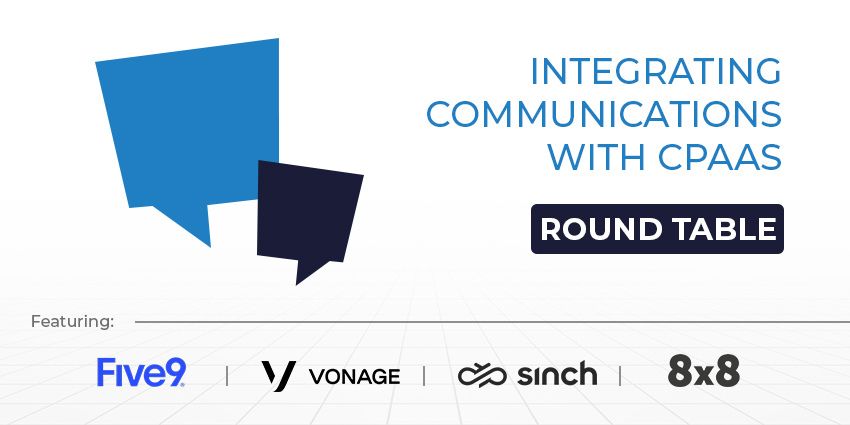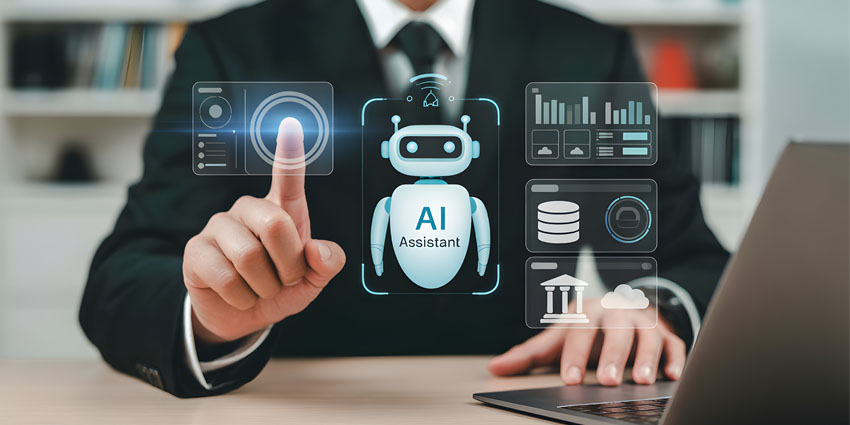The communications landscape is evolving at an unprecedented pace, driven by the rise of intelligent platforms that integrate AI, automation, and multichannel messaging.
CPaaS (Communications Platform as a Service) is at the heart of this transformation, enabling companies to embed communication and automation directly into workflows and applications.
With increasing demand for efficiency, reliability, and richer engagement, organizations are turning to conversational intelligence to reduce friction and elevate experiences across multiple channels.
From messaging apps to voice interactions, CPaaS platforms are helping businesses maintain context, anticipate needs, and deliver faster, more meaningful responses. These tools not only improve customer satisfaction but also empower employees with the insights and automation they need to perform their roles more effectively.
For our latest UC Round Table topic, Integrating Communications with CPaaS, we spoke with experts and executives from Sinch, Vonage, Five9, and 8×8 about how CPaaS is driving workflow automation and creating seamless customer and employee experiences.
We explored the opportunities and challenges associated with conversational intelligence, automation, and maintaining the human touch in an increasingly AI-driven environment.
How is the integration of conversational intelligence into CPaaS platforms reshaping customer and employee experiences?
Conversational intelligence is enabling CPaaS platforms to deliver smarter, more natural interactions that reduce friction and improve satisfaction. For customers, this means personalized communications across messaging apps, SMS, and voice, where context is preserved across channels. For employees, AI-powered insights streamline workflows and internal communications, allowing teams to act faster and more efficiently.
Anna Jäger, Vice President of Marketing, Sinch
Jäger emphasizes the transformative role of Rich Communication Services (RCS) in making messaging more interactive, trustworthy, and engaging.

“One major trend shaping the CPaaS market today is the growing adoption of Rich Communication Services, or RCS—a next-generation messaging protocol that brings richer, more secure, and interactive features to standard messaging. With Apple supporting RCS, over a billion iOS devices are joining the ecosystem, giving brands the ability to reach the entire mobile market. RCS makes messaging feel more like using an app. Brands can send video, audio, images, and interactive buttons, all within the chat. Sinch reports that seventy-four percent of users are more likely to engage with a brand through RCS, and seventy-seven percent prefer verified messages, which build trust and credibility. We’re on the edge of a significant shift: just as SMS became universal, we believe RCS is on track to reach full global penetration—that’s five to six billion unique users. For brands, this opens up a huge opportunity to connect with customers in a much more dynamic and trusted way.”
Aaron Seyler, SVP, Global CPaaS, Vonage
Seyler highlights how conversational intelligence removes friction and supports richer, more natural experiences for both customers and employees.
“Bringing conversational intelligence into CPaaS removes friction and creates more seamless customer interactions across channels. Customers no longer need to repeat themselves when moving between channels like SMS, messaging apps, or voice calls, because the context is carried through. With AI-powered bots and proactive notifications, interactions become faster, more personalized, and more natural to help build stronger relationships and loyalty. On the employee side, conversational intelligence makes internal communications smarter and more responsive. For example, HR teams can send timely company-wide updates on the channels employees prefer, from routine announcements to urgent alerts during a security incident. They can also gather quick feedback through post-training surveys delivered via a messaging app, increasing response rates to help the business act on insights faster.”
Thomas John, AVP EMEA & APAC, Five9
John explains the benefits for agents and customers, emphasizing efficiency and context-aware interactions.
“Conversational intelligence lets CPaaS platforms do more than general calls. It helps to analyse sentiment, summarise interactions, and provide real-time guidance. It can also provide agents with instant insights during a call, which helps reduce resolution times and improve consistency. For customers, it brings more natural, personalised interactions, even where some parts of the experience are automated, and for employees—less manual work, less frustration, better tools.”
Chris Angus, VP of CPaaS & CX Expansion, 8×8
Angus stresses the integration of AI into core CPaaS functions, reshaping experiences for both customers and employees.
“This isn’t just a bit of change. It’s a complete redefining of what ‘good’ looks like in customer and employee experience and it can help businesses turn every interaction into a strategic advantage. At 8×8, we see conversational intelligence as the great enabler—not a bolt-on, but a core function that’s transforming the way customers engage and employees work. Traditionally, CPaaS has been about connectivity, but now, with AI-powered conversational intelligence woven directly into the fabric of those channels, we’re seeing a change.
For customers, it means smarter, faster interactions. AI agents aren’t just routing calls—they can be holding real conversations, extracting sentiment, and escalating with full context. Whether it’s rebooking a flight or checking a delivery status, interactions are personalised, accurate, and frictionless. For employees, especially contact centre agents, it’s a game changer. AI now summarises calls, flags compliance risks, and recommends next-best actions in real time. That’s reduced burnout, boosted productivity, and improved first-call resolution.”
In what ways can CPaaS-driven workflow automation reduce friction in communications and drive measurable business outcomes?
Workflow automation reduces manual handoffs, speeds up communication, and ensures that both employees and customers experience seamless interactions. Automation can handle routine tasks, freeing human agents for higher-value work, and supports real-time routing, CRM integration, and analytics.
Anna Jäger, Vice President of Marketing, Sinch
Jäger details how the WhatsApp Business API empowers businesses to streamline communication and automate processes.
“The WhatsApp Business API offers professional-grade tools for business communication and automation. Unlike the basic app, the API provides access to chatbots, automated workflows, SMS integration, and comprehensive social media analytics. You have two main options for using these capabilities. A custom API implementation is best for businesses with an in-house development team to build their own solution. Alternatively, a turnkey solution is available through official WhatsApp Business Solution Providers for teams who want to get started quickly without any coding. Both options provide the same benefits, including unlimited agents, automated messaging, and tools for chatbots, CRM integration, and analytics. The API helps various industries boost customer engagement. Retailers can send delivery updates, and clinics can automate appointment reminders. Logistics companies can trigger proactive delay notifications. Everything is managed from a central inbox accessible to anyone in the company, with no agent limits, resulting in fewer missed connections and lower support costs.”

Aaron Seyler, SVP, Global CPaaS, Vonage
Seyler underscores that automation streamlines operations, reduces errors, and accelerates response times.
“CPaaS-driven automation reduces friction by cutting out the extra steps that slow communication down. Instead of siloed systems and manual handoffs, APIs allow businesses to automate actions like sending order updates, verifying identities, or routing messages based on real-time triggers. This keeps interactions moving without interruptions and ensures information reaches the right person or channel at the right moment. The business outcomes are tangible, with faster processes, lower costs, and fewer errors. Automation reduces the volume of routine inquiries, speeds up the delivery of critical information, and shortens the time it takes to move from request to resolution. It also allows developers to spin up new features quickly, whether by embedding video into an app, launching two-factor authentication, or enabling secure workflows to accelerate innovation and time to market. Combined, these efficiencies will drive measurable gains in productivity, agility, and revenue growth.”
Chris Angus, VP of CPaaS & CX Expansion, 8×8
Angus demonstrates real-world results of CPaaS-driven automation, from logistics to billing, showing how it reduces manual work and drives revenue.
“CPaaS-driven automation removes friction when done properly. At its core, CPaaS is about flexibility and scalability. That’s why it’s the perfect foundation for streamlining and automating existing workflows, enabling businesses to move faster. Imagine a logistics company dealing with daily shipment status inquiries. With 8×8 CPaaS APIs and AI integration, you can automate the entire flow: the customer sends a message, the system authenticates them silently, pulls status data from the backend, and responds—all without human involvement. That reduces inbound agent volume and eliminates delays, freeing up staff for high-value tasks. In billing scenarios, virtual agents can negotiate payments, send follow-up SMS confirmations, and even handle secure transactions with our digital wallet integration. It’s automation that drives revenue, not just efficiency. This isn’t potential and ‘maybes’—it’s happening now. For example, one customer saw a forty-three percent year-on-year increase in CPaaS interactions after adopting automated engagement models. We’ve reduced onboarding time to less than one day with pre-configured templates. When CPaaS becomes more than transport and starts handling logic, routing, and personalisation, you unlock exponential business value.”
Thomas John, AVP EMEA & APAC, Five9
John highlights how workflow automation connects systems and eliminates manual handoffs, improving efficiency and consistency.
“Workflow automation bridges disconnected systems, for example, it can let organisations integrate their contact centre with CRMs, marketing tools, knowledge bases, etc., and automate cross-platform workflows. This reduces manual handoffs, avoids delays, and improves consistency. Business outcomes include shorter resolution times, higher customer satisfaction, and better agent efficiency.”
What are the most promising use cases of CPaaS-powered conversational intelligence you expect to see widely adopted in the next few years?
Companies are exploring ways to harness conversational intelligence for highly targeted and personalised experiences. CPaaS is enabling use cases that were previously impractical, from AI-driven customer support to interactive, rich messaging campaigns. These applications will expand across retail, healthcare, financial services, and beyond, offering measurable gains in engagement, conversion, and operational efficiency.
Chris Angus, VP of CPaaS & CX Expansion, 8×8

Angus lays out a multi-year vision for CPaaS, covering RCS adoption, AI-driven follow-ups, silent authentication, and hyper-personalised WhatsApp campaigns.
“The next wave of conversational intelligence in CPaaS is already forming. What’s coming is more than AI agents or virtual agents—it’s going to be real-time, AI-powered conversations that are personalised, predictive, and profitable. RCS is quickly emerging as the next big shift in messaging. With Apple adopting RCS in 2025, the path is set for it to become a universal standard. While SMS will remain a reliable fallback, customers increasingly expect richer, more interactive experiences. Another big thing is going to be intent-based routing and deflection. At 8×8 we’re already seeing seventy percent-plus containment rates where bots handle full conversations end-to-end. Next-gen bots will detect tone, urgency, and context in real time, escalating not just if needed, but how and to whom, dynamically. Then there’s AI-driven follow-ups. Post-call summaries, automatic personalised emails, and sentiment-aware offers, powered by real-time analytics via CPaaS. In industries like healthcare and finance, silent authentication is another breakout use case. Voicebots for payments and billing are gaining steam. The CPaaS of tomorrow is intelligent, responsive, and context-aware—and scalable. It’s going to be a really exciting few years.”
Anna Jäger, Vice President of Marketing, Sinch
Jäger emphasises the impact of RCS business messaging for campaigns like Black Friday, showing how rich, interactive messages drive immediate engagement.
“An exciting use case we expect to become widely adopted is Rich Communication Services (RCS) business messaging as a powerful tool for campaigns like Black Friday and Cyber Monday. This provides an interactive experience in a customers’ native mobile messaging inboxes. RCS allows businesses to send eye-catching promotions that mix text, high-quality images, and interactive elements like buttons and carousels, helping brands to stand out during the BFCM rush. In fact, ninety percent of rich media messages are opened within fifteen minutes, and customers engage with RCS content for up to forty-five seconds. This lets shoppers browse deals, make purchases, or get more information without ever leaving the messaging app. For example, the French fashion retailer Citadium used RCS to send branded messages with a forty percent off site-wide deal. Interactive buttons in the message allowed shoppers to go directly to specific product categories.”
Aaron Seyler, SVP, Global CPaaS, Vonage
Seyler identifies conversational intelligence use cases in healthcare, finance, and retail, highlighting context-aware interactions and proactive support.
“In healthcare, we will see conversational intelligence continue to advance telehealth services, so patients get more comfortable in scheduling, confirming, and adjusting appointments directly through apps or messaging, with proactive reminders and follow-ups that carry context through the entire journey. Overall, this will reduce appointment no-shows and make care access smoother. We also might see more promise in CPaaS-powered capabilities in financial services and insurance. These capabilities can enhance security and trust, building on workflows like two-factor authentication, which can adapt in real time to detect fraud risks while keeping verification seamless for legitimate users. Finally, in retail, businesses will continue integrating the technology to create more personalized engagements, from tailored promotions delivered through a customer’s preferred channel to automated post-purchase surveys and proactive support to enhanced messaging capabilities through RCS, including the ability to buy directly from within an SMS interaction through an RCS Carousel and other in-app experiences. These context-aware interactions are the next wave of customer engagement and will be key to keeping customers coming back and feeding smarter business pivots and decisions.”
Thomas John, AVP EMEA & APAC, Five9
John predicts that real-time agent assist, proactive AI outreach, and unified analytics will become widespread, enabling smarter, faster customer interactions.
“CPaaS-powered conversational intelligence is set to transform customer engagement by enabling real-time agent assist, proactive AI-driven outreach, and unified analytics across every channel. These capabilities will not only anticipate customer needs and personalize interactions but also ensure automated compliance monitoring, making conversational intelligence the engine driving smarter, faster, and more trusted customer experiences.”
How can organizations balance automation through CPaaS with maintaining a human touch in customer and employee interactions?
Organizations must orchestrate automation and human interaction to create seamless, efficient, and empathetic experiences. Automation can handle repetitive or high-volume tasks, but human intervention remains essential for complex, emotional, or context-sensitive scenarios.
The key is creating a hybrid model where AI-powered bots assist humans, preserve context across channels, and escalate intelligently when necessary. This ensures that customers and employees experience both speed and a human touch, building trust and satisfaction while maintaining operational efficiency.
Anna Jäger, Vice President of Marketing, Sinch
Jäger stresses that bots and humans are most effective when they collaborate in an integrated system.
“You can get the best customer service by having bots and humans work together as a team. Instead of trying to replace humans with bots, smart businesses find ways for them to collaborate and benefit from each other’s unique strengths. The key to this successful partnership is a connected system where both bots and human agents can access and store customer information. When your AI-powered virtual assistants and customer care systems are integrated, they can achieve the best results. This allows bots to operate more efficiently and helps human agents give customers the best possible assistance. When setting up a hybrid customer service system, focus on how bots and humans can work together to improve customer service, rather than on replacing one with the other.”
Aaron Seyler, SVP, Global CPaaS, Vonage
Seyler highlights the orchestration of automation and human interaction to deliver both speed and empathy.
“The real value of CPaaS is not about choosing between automation and people but orchestrating both. Automation delivers valuable speed and consistency by handling high-volume tasks like reminders, confirmations, and verifications. But CPaaS also makes it easy to recognize when a conversation needs empathy or judgment to transition to a person without losing the context. This ensures customers experience the convenience of automation and the reassurance of human connection to create interactions that are both efficient and genuinely engaging.”

Thomas John, AVP EMEA & APAC, Five9
John emphasizes tools that ensure AI and humans work together seamlessly and empathetically.
“There are tools that allow organisations control how much autonomy AI has, while making sure human agents take over for sensitive or complex issues. It also ensures virtual agents and bots use well-designed scripts and have access to the customer’s history/context which helps them feel more human and less robotic. In addition, monitoring quality, sentiment, and getting feedback allows the system to be adjusted in order to ensure interactions stay empathetic.”
Chris Angus, VP of CPaaS & CX Expansion, 8×8
Angus notes that automation and humans are allies, not opposites, and highlights the importance of escalation and context.
“Automation should never come at the expense of humanity. I’ve said for years, even when everyone else was talking about tech replacing all the humans, automation and humans are not opposites—they’re allies. The secret is knowing where to automate and when to escalate. Good CPaaS solutions are built to support both sides. Automate the routine so your people can focus on the moments that matter. For example, AI agents handling order lookups, password resets, or appointment reminders, but as soon as emotion, escalation, or complexity enter the conversation, pass the conversation over to a human with full context. Automation without humanity feels robotic. Humanity without automation doesn’t scale. You need the balance for the best customer experience.”
What security, privacy, and compliance considerations should organizations prioritize when deploying CPaaS solutions enhanced with conversational intelligence?
Deploying CPaaS with conversational intelligence requires careful attention to protecting sensitive information, maintaining regulatory compliance, and ensuring ethical use of AI. Organizations must secure data both at rest and in transit, monitor access to AI systems, and stay compliant with local and international regulations. Balancing innovation with trust is critical, as customers and employees expect seamless experiences without compromising privacy or security. Security strategies should include multi-layered protection, real-time fraud detection, and regular audits to maintain integrity and confidence in communications systems.
Anna Jäger, Vice President of Marketing, Sinch
Jäger underlines that security, privacy, and compliance should be integral to the CPaaS solution from the start.
“When deploying CPaaS solutions enhanced with conversational intelligence, organizations should prioritize several key security, privacy, and compliance considerations. For security, it’s crucial to choose a provider that employs a multi-layered security approach. This includes protecting data with both encryption at rest and in transit. A robust security strategy also includes continuous monitoring, penetration testing, and vulnerability scanning to prevent unauthorized access or breaches. On privacy and compliance, businesses must be aware of local and global regulations, such as GDPR and HIPAA. These regulations govern the collection, storage, and processing of personal data. CPaaS platforms often offer tools to help maintain compliance, like message archiving, consent management, and access control. Ensuring proper governance policies and employee training are also critical.”
Aaron Seyler, SVP, Global CPaaS, Vonage
Seyler emphasizes safeguarding sensitive information and respecting user preferences across channels.
“Privacy and trust are everything. When using CPaaS with AI, organizations must make sure customer data is encrypted, anonymized where necessary, and never shared without consent. Compliance is not just a checkbox; it’s about creating an infrastructure where interactions are safe, traceable, and auditable. From a regulatory perspective, this includes GDPR, HIPAA, PCI-DSS, and any other sector-specific requirements. Organizations should embed security at the design stage—meaning the system is secure by default and resilient against breaches. Transparency is key. Customers and employees must know how their data is used, what is automated, and how AI decisions are made.”
Thomas John, AVP EMEA & APAC, Five9
John outlines the need for comprehensive governance and regulatory compliance alongside data protection.
“Security, privacy, and compliance are critical in CPaaS. Encryption of messages, secure authentication, and robust access controls are foundational. Compliance frameworks should be embedded into the system, covering GDPR, HIPAA, PCI-DSS, and other regional laws. Auditing capabilities allow tracking of all communication flows and AI interactions to ensure full accountability.”
Chris Angus, VP of CPaaS & CX Expansion, 8×8
Angus discusses security as foundational, with silent authentication and AI governance as emerging best practices.
“Every CPaaS deployment must be designed around security, privacy, and compliance from day one. Encryption, access controls, audit logs, and regular penetration tests are non-negotiable. When AI is involved, it is essential to know what data the AI uses, how it’s stored, and to ensure it’s compliant with regulations. Businesses should also make sure customers and employees are informed of their rights and that consent is actively managed. Ultimately, CPaaS success depends on trust—without it, even the smartest AI-powered systems fail.”







